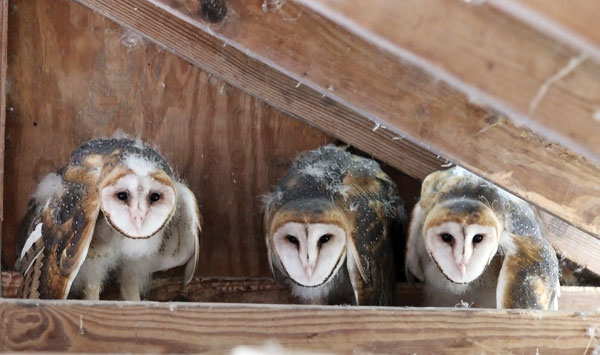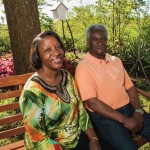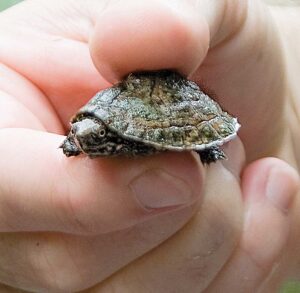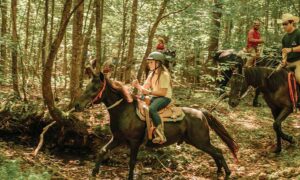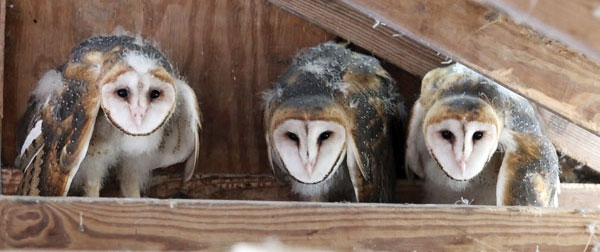
Story by Carol Pappas
Photos by Jerry Martin
and Kathy Henry
Hagan, the last of the barn owls to leave their roost in July, flew the coop from an unlikely perch — the rafters of a covered pier on Pell City’s Logan Martin Lake.
He, his brothers and mother took up residence some weeks earlier. The mother first, of course, and brothers coming along later, hatching a few days apart.
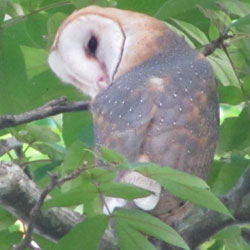 They didn’t seem to give a hoot about their unusual surroundings of water instead of land. In fact, barn owls don’t hoot at all. Their vocal repertoire is more like a blood-curdling scream, the kind Alfred Hitchcock might fancy to play a role in a terrifying scene.
They didn’t seem to give a hoot about their unusual surroundings of water instead of land. In fact, barn owls don’t hoot at all. Their vocal repertoire is more like a blood-curdling scream, the kind Alfred Hitchcock might fancy to play a role in a terrifying scene.
It seems only fitting that a ghoulish face and silent wings in flight, swooping toward their prey at night, would make this scene complete. Hitchcock would be proud.
For Kathy Henry, owner of the last known address for Hagan and his older brothers, Aaron and Mit, her visitors haven’t been frightening at all. That is, unless you count the time one night when the mother silently swooped down behind Henry and friends, letting out that scream because she thought her young were in danger.
The owl lunged toward the family boxer, “and he took off running like a sane person — as did we. She screamed four times until we got to the door,” Henry said.
Other than that near miss, owl watching has been an entertaining pastime around the Henry property. She rigged a Wingscapes BirdCam she dubbed “owl cam” to a PVC pipe to watch as the family grew. She named them. “The first born was Aaron, after the friend that found them. The middle born was Mit, after a friend of ours who has overcome an extreme fear of birds and now loves birds. And the youngest was named after the 4-year-old grandson of our favorite neighbor.
“Hagan, the owl, was hatched about five days after we found the first two, and Hagan, the human, climbed up and was the first to see it,” Henry said.
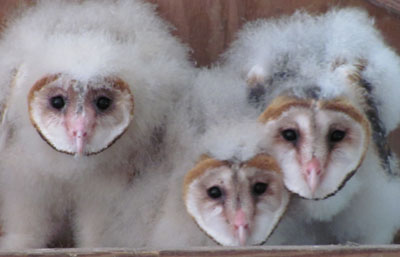 Barn owls hatch their young in the order the eggs were laid, so when the youngster climbed the ladder to look and came down saying there were three, she tried to correct him. When he didn’t give up, she ascended the ladder to see for herself and discovered the trio staring back at her.
Barn owls hatch their young in the order the eggs were laid, so when the youngster climbed the ladder to look and came down saying there were three, she tried to correct him. When he didn’t give up, she ascended the ladder to see for herself and discovered the trio staring back at her.
Over the owls’ month-long stay, Henry, a pharmacist by trade, has learned all about her winged friends. “They nest in caves, hollowed trees and old buildings,” she said. But somehow, they took a turn across the water and ended up at Henry’s lakeside place. “I think it was because she (the mother) knew they would be safe. At least I like to tell myself that.”
She has taken dozens of photos and hours of footage, studied their habits and shared her knowledge with other curious onlookers. But it never seemed to faze those being looked upon.
Perhaps Henry’s right. They knew they were safe. “It’s been fun,” she said. “I really enjoyed it. I hope they come back.”











